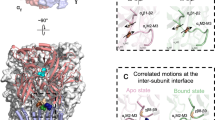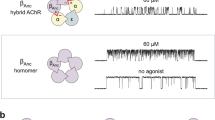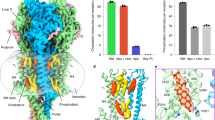Abstract
IN nicotinic acetylcholine receptors (nAChR), as well as glycine, GABAA (γ-aminobutyric acid), serotonin (5-HT3), and GluCl glut-amate receptors, a leucine residue at the approximate midpoint of the M2 transmembrane domain (the 9′ position1) is conserved across most known subunits2. Structural data for the nAChR suggest that the Leu 9′ residues occupy a ᤘkinkᤙ in each of the five M2 helices and point into the closed channel; in the opening step, the M2 helices rotate so that Leu 9′ side chains no longer occlude the conduction pathway3. Mutation of Leu 9′ to one of several other residues slows desensitization and increases sensitivity to agonist4á¤-6. We have exploited the α2βγδ stoichiometry of muscle nAChR to express receptors with ms* = 0 to 5 Leu 9′Ser mutated subunits. Strikingly, each Leu 9′Ser mutation shifts the dose-response relation for ACh to the left by ~10-fold; a nAChR with ms* = 4 is 104-fold more sensitive than the wild type. The results suggest that each of the five Leu 9′ residues participates independently and symmetrically in a key step in the structural transition between the closed and open states.
This is a preview of subscription content, access via your institution
Access options
Subscribe to this journal
Receive 51 print issues and online access
$199.00 per year
only $3.90 per issue
Buy this article
- Purchase on Springer Link
- Instant access to full article PDF
Prices may be subject to local taxes which are calculated during checkout
Similar content being viewed by others
References
Charnet, P. et al. Neuron 2, 87–95 (1990).
Lester, H. A. A. Rev. Biophys. biomolec. Struct. 21, 267–292 (1992).
Unwin, N. Nature 373, 37–43 (1995).
Revah, F., Bertrand, D., Galzi, J. L., Devillers-Theiry, A. & Mulle, C. Nature 353, 846–849 (1991).
Akabas, M. H., Stauffer, D. A., Xu, M. & Karlin, A. Science 258, 307–310 (1992).
Yakel, J. L., Lagrutta, A., Adelman, J. P. & North, R. A. Proc. natn. Acad. Sci. U.S.A. 90, 5030–5033 (1993).
Sigurdson, W., Chen, J., Akabas, M., Karlin, A. & Auerbach, A. Biophys. J. 66, A212 (1994).
Jackson, M. B. Proc. natn. Acad. Sci. U.S.A. 81, 3901–3904 (1984).
Leonard, R. J., Labarca, C., Charnet, P., Davidson, N. & Lester, H. A. Science 242, 1578–1581 (1988).
Devillers-Thiery, A., Galzi, J. L., Bertrand, S., Changeux, J. P. & Bertrand, D. Neuroreport 3, 1001–1004 (1992).
Wathey, J. C., Nass, M. N. & Lester, H. A. Biophys. J. 27, 145–164 (1979).
Quick, M. W. & Lester, H. A. in Ion Channels of Excitable Cells (ed. Narahashi, T.) 261–279 (Academic, San Diego, 1994).
Sigworth, F. J. & Sine, S. M. Biophysical J. 52, 1047–1054 (1987).
Nowak, M. W. et al. Science 268, 439–441 (1995).
Ohno, K. et al. Proc. natn. Acad. Sci. U.S.A. 92, 758–762 (1995).
Author information
Authors and Affiliations
Rights and permissions
About this article
Cite this article
Labarca, C., Nowak, M., Zhang, H. et al. Channel gating governed symmetrically by conserved leucine residues in the M2 domain of nicotinic receptors. Nature 376, 514–516 (1995). https://doi.org/10.1038/376514a0
Received:
Accepted:
Issue Date:
DOI: https://doi.org/10.1038/376514a0
Comments
By submitting a comment you agree to abide by our Terms and Community Guidelines. If you find something abusive or that does not comply with our terms or guidelines please flag it as inappropriate.



